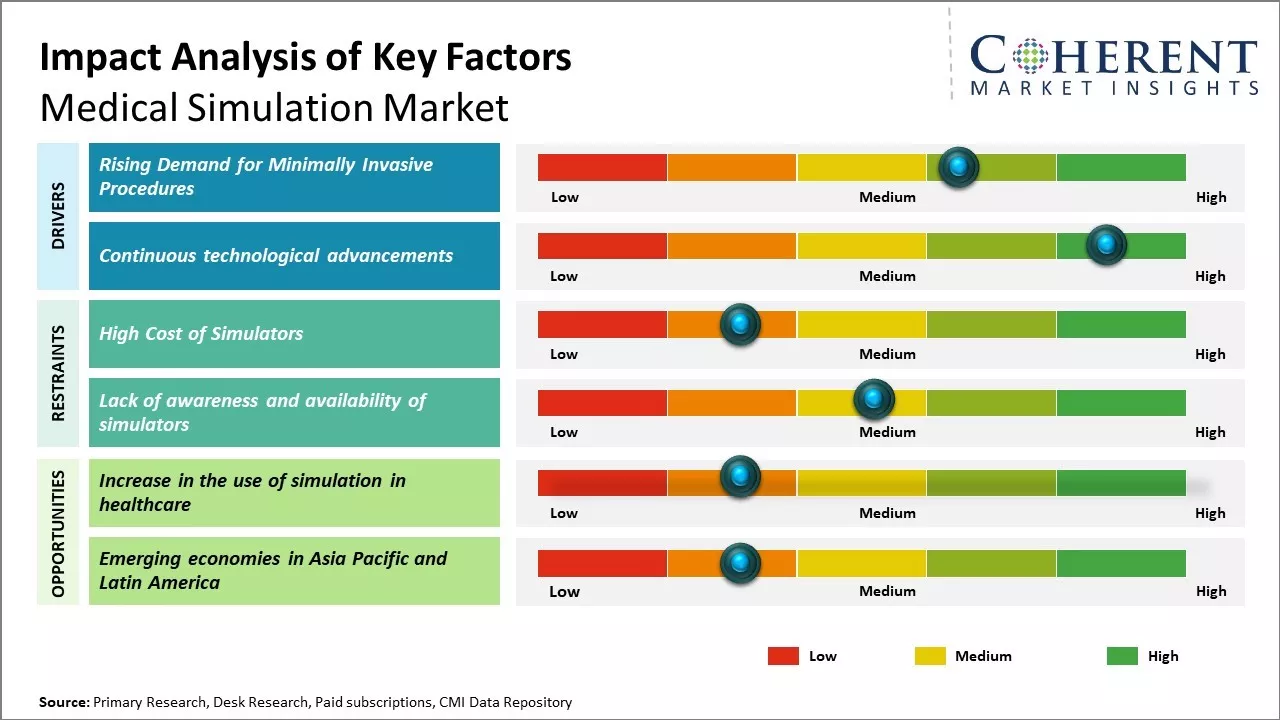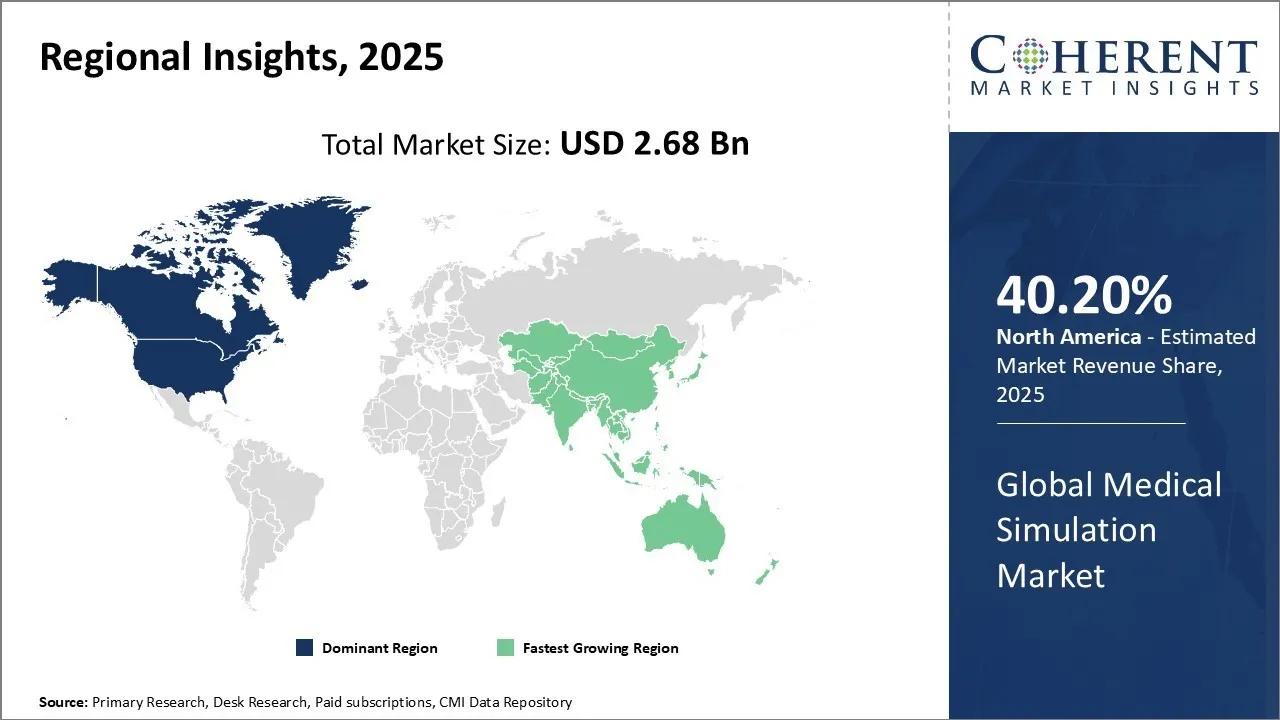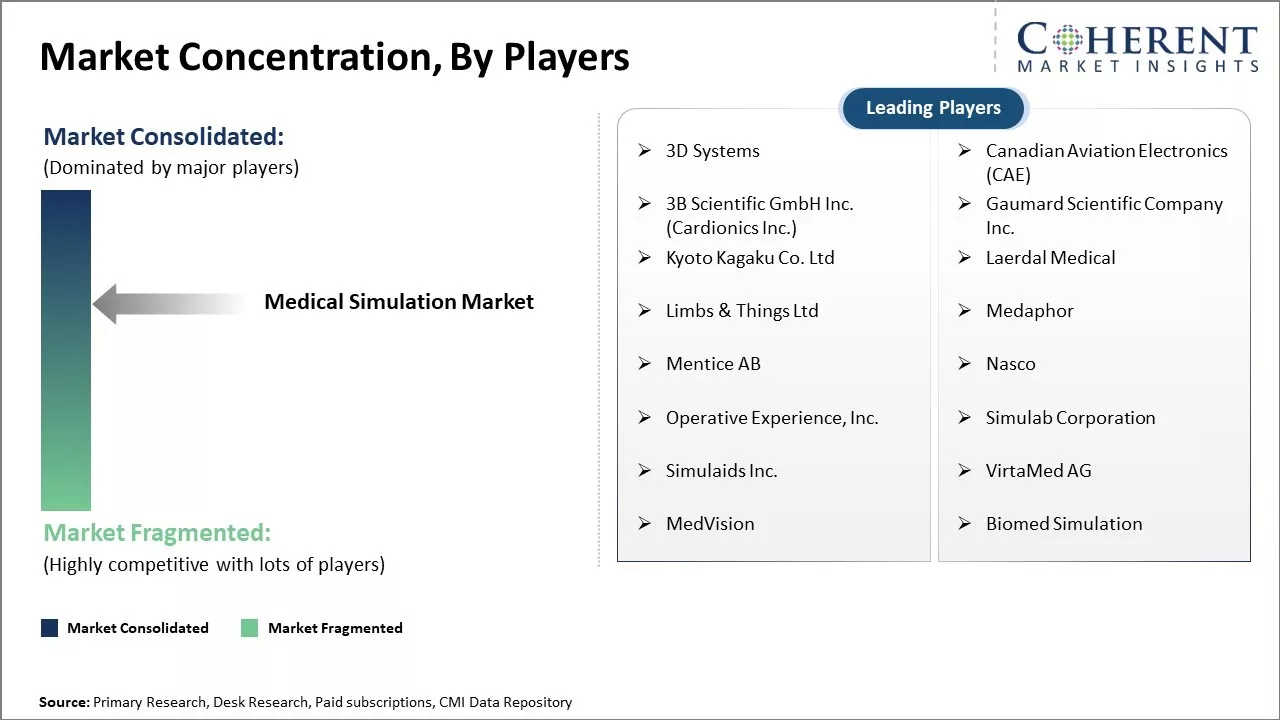Global medical simulation market is estimated to be valued at USD 2.68 Bn in 2025 and is expected to reach USD 7.58 Bn by 2032, exhibiting a compound annual growth rate (CAGR) of 16.0% from 2025 to 2032.

To learn more about this report, Download Free Sample
The medical simulation market demand is expected to witness significant growth over the forecast period. Key factors such as increasing focus on patient safety, rising adoption of virtual training, growing demand for minimally invasive treatments, and shortage of healthcare professionals are expected to drive the demand for medical simulation. Furthermore, rapid advancements in technology such as virtual reality, augmented reality, and mixed reality are also helping medical colleges and healthcare institutions to leverage medical simulation for training purposes. Throughout the projected period, growing patient safety concerns are anticipated to fuel the worldwide medical simulation market's expansion. For instance, the World Health Organization's Global Patient Safety Action Plan [2021–2028] offers a framework for nations to create their own national patient safety action plans and to coordinate the use of current strategic instruments for enhancing patient safety in all clinical and health-related programs. The market for medical simulators is likely to develop as a result of this, or it has already raised demand for medical simulators.
|
Current Event |
Description and its Impact |
|
Technological Innovation in Simulation Training |
|
|
Healthcare Workforce Shortages and Training Reforms |
|
Uncover macros and micros vetted on 75+ parameters: Get instant access to report
The integration of artificial intelligence is profoundly transforming the medical simulation market by enhancing realism, efficiency, and outcomes in clinical training. AI can generate dynamic, personalized training scenarios based on a learner’s performance, specialty, or real-world case data. For example, if a medical student struggles with pediatric trauma scenarios, the AI can adjust the simulation to provide more relevant challenges and feedback. AI systems can analyze trainee actions in real time by tracking hand movement, decision timing, and procedural accuracy to give immediate, personalized feedback. This helps learners improve faster and ensures standardization in assessment. AI enhances realism in AR/VR simulations by modeling patient behavior, complications, and environmental responses. In robotic surgery training, AI helps simulate complex anatomical variations and outcomes.
In January 2024, The All‑India Institute of Medical Sciences (AIIMS) and IIT Delhi have jointly developed cutting‑edge, AI‑based simulation training modules for neurosurgery. These simulators offer realistic, 3D‑printed brain models and use computer vision and machine learning to objectively assess precision, speed, and decision‑making in minimally invasive microscopic and endoscopic procedures.
In terms of products and services, interventional/surgical simulators segment is expected contribute the highest share of 69.6% the market in 2025, owing to ongoing technological advancements. Interventional/surgical simulators have evolved tremendously over the past few years with integration of augmented reality, virtual reality and artificial intelligence. New-age simulators closely mimic real-life surgical environments and provide an ultra-realistic experience to medical professionals. Hospitals and medical schools increasingly prioritize risk-free training environments. Simulators allow surgeons, nurses, and technicians to practice procedures without endangering patients, helping reduce medical errors and malpractice cases. Altogether, interventional/surgical simulators are continuously demanding in medical simulation market as they enable safer, faster, and more effective training for increasingly complex procedures while aligning with technological innovation and global healthcare needs.
In October 2024, Inovus Medical launched a suite of advanced training modules for its hysteroscopy simulators, enhancing surgical education in gynaecology. The expanded toolkit includes scenarios for retained products of conception, uterine septum, dilation and curettage, and endometrial ablation/resection—allowing trainees to hone vital procedural skills in a controlled, simulated setting. Inovus says the updates aim to bridge the gap between theory and clinical practice, improving confidence and patient safety through realistic, hands‑on immersion.
In terms of technology/fidelity, high-fidelity simulators segment contributes the highest share of the market 40.62% owing to their unmatched ability to simulate real-life operating conditions. High-fidelity models offer an exceptional level of physical, visual and tactile realism compared to lower fidelity variants. They closely mimic original anatomical structures, realistic haptic feedback, organ elasticity and tissue properties. The high-resolution touch and visual displays provide an authentic immersive surgical experience. Furthermore, high-fidelity models integrate augmented reality interfaces with complex programming logic to allow situational training scenarios. Models can simulate unexpected complications, errors and change surgical settings on the fly. This makes skills training more challenging and contextual thereby enhancing learning outcomes. Due to their true-to-life characteristics, high-fidelity simulators are highly preferred for skills assessment, certification and team-based training activities. Leading manufacturers continue advancing simulation quality through haptics, miniaturization and web-based access to drive further penetration of this segment.
In April 2025, Manipal Academy of Higher Education (MAHE) introduced Asia’s first “Mama Anne” high-fidelity birthing simulator at Kasturba Medical College, Manipal. This cutting-edge training tool mimics realistic obstetric and maternal resuscitation scenarios to enhance hands-on learning for medical professionals.
In the medical simulation market, hospitals stand out as the most dominating segment with market share of 52.62% due to the utilization of simulation technologies extensively for training healthcare professionals and emphasizing patient safety and quality care. With dedicated simulation centers and a strong commitment to staff training, hospitals hold the highest market share in the medical simulation market. Simulation allows healthcare professionals to practice complex and high-risk procedures such as intubation, surgery, or code blue scenarios, without putting real patients at risk. This leads to better preparedness and fewer real-world mistakes. Accrediting bodies like the Joint Commission and ACGME encourage or require simulation-based training for quality assurance, continuing education, and certification renewals.
In September 2024, Narayana Health City launched its new Advanced Simulation Centre, a state‑of‑the‑art facility dedicated to hands‑on training for ICU nurses. The centre features realistic patient simulators, mechanical ventilators, cardiac monitors, and other essential critical‑care equipment. It is designed to enhance clinical decision‑making, teamwork, and confidence, the simulation‑based curriculum aims to improve patient outcomes and reduce ICU complications. This is further proliferating the medical simulation market growth.

To learn more about this report, Download Free Sample
North America has established itself as the dominant regional market for medical simulation market in 2025 for 40.2% medical simulation market share. With the presence of numerous industry leaders and innovators based in the U.S. and Canada, the region accounts for the largest share of global revenues. A prime example is HCA Florida Orange Park Hospital, which recently opened a USD 3 million, 15,000 sq ft Graduate Medical Education Simulation Center featuring advanced mannequins and clinical spaces, enabling residents to rehearse critical scenarios safely.
Countries in North America have also placed greater emphasis on advanced training for healthcare professionals through the use of simulation technologies. This has encouraged wider adoption across medical schools and hospitals. Similarly, Goodwin University in Connecticut is investing USD 3 million to launch a comprehensive nursing simulation lab equipped with high-fidelity simulators for pediatric, hospice, and emergency care training. Furthermore, healthcare organizations have shifted towards procedural and skills training with simulators to reduce costs and risks compared to human practices. North American institutions increasingly prioritize simulator-based procedural and skills training to reduce costs, enhance patient safety, and meet accreditation standards, solidifying the region’s dominance in the medical simulation market.
The Asia Pacific region has emerged as the fastest growing medical simulation market forecast, driven by rapid investment in healthcare infrastructure across countries like China, India, Japan, and South Korea are investing heavily in their healthcare sectors and medical infrastructure. For instance, in Nagpur, the Government Dental College has launched India’s first dental simulation lab part of a new modular OT facility—to train students in real-world procedures like X-rays and dental surgeries under realistic conditions, improving patient safety and clinical competency. This has increased the focus on medical education and improving clinical competencies. The large patient pools and growing medical tourism industries and populations with higher disease burdens have also boosted investments towards simulation-based solutions. Additionally, the availability of low-cost manufacturing capabilities coupled with government support has resulted in Asian companies aggressively expanding their presence and challenging global vendors. This has made the Asia Pacific a lucrative and dynamic medical simulation market growth.
The U.S. medical simulation market is becoming essential especially at premier institutions like Mayo Clinic and Johns Hopkins. For instance, Mayo Clinic’s J. Wayne and Delores Weaver Simulation Center in Florida, spanning 9,600 sq ft—enables teams to rehearse high-stress scenarios such as Code Blue and robotic surgery before treating real patients, significantly enhancing preparedness and patient outcomes. At Johns Hopkins, the annual Advanced Pediatric Anesthesiology Fellowship Bootcamp utilizes high-fidelity simulations and disaster drills to prepare fellows for complex pediatric cases. These programs, supported by accreditation standards from bodies like ACGME and the Joint Commission, integrate medical simulation across medical schools, hospitals, and even military healthcare, providing realistic training that reduces errors and builds interdisciplinary teamwork in a risk-free environment.
In India, the medical simulation market is gaining momentum due to rapid expansion of medical colleges and private hospitals, offering critical hands-on training where clinical exposure is limited. For example, CMC Vellore recently inaugurated an advanced simulation lab funded by a USD 1 million USAID grant to improve maternal and neonatal care by training doctors and nurses in emergency procedures, CPR, and neonatal resuscitation. Similarly, KD Hospital in Ahmedabad launched Gujarat’s first high-tech nursing simulation academy (KD‑SAIL), featuring AR/VR zones and high-fidelity mannequins for ICU, PICU, and labor-room scenarios filling the gap between theory and real-world practice. As India’s healthcare system scales up, simulation labs are proving essential for reducing risk, enhancing competency, and strengthening the quality of care across urban and rural settings.
Germany’s medical simulation market is characterized by highly advanced healthcare system across undergraduate and continuing education programs. For example, Magdeburg University Hospital was recently designated an official training center by the German Society of Neuroradiology, offering hands‑on simulator courses in stroke therapy and interventional neuroradiology to build technically proficient specialists. Meanwhile, student-led initiatives like Universität Hamburg’s SimLab are enabling aspiring surgeons to practice minimally invasive techniques using 3D‑printed organ models and laparoscopic tools, strengthening technical and problem‑solving skills. These developments illustrate how Germany’s government-supported education reforms and the growing need for technical competence are fueling simulation-based learning across multiple clinical disciplines and career stages.
The demand for minimally invasive procedures is on a steady rise across the globe. As these procedures offer advantages like lesser pain, fewer complications, shorter hospital stay, and faster recovery time; more and more patients are opting for them. This has brought immense pressure on the healthcare systems to train more professionals in complex minimally invasive techniques. Medical simulation provides a safe, controlled, and risk-free environment for training surgeons and other medical professionals in conducting such advanced procedures. Through simulation, they can learn and practice complex hand movements required without any fear of harming actual patients. The most significant factors that patients considered when deciding between open and minimally invasive surgery (MIS) were complication risk, surgeon recommendation, and long-term outcomes, according to a research article titled "Comparison of Patient Preference, Understanding, and Sentiment for Minimally Invasive Versus Open Spine Surgery" that was published in Clinical Spine Surgery. Patients felt that MIS surgery was better than open surgery in terms of anesthesia requirements, recovery times, cost, and postoperative discomfort and complication risk. The majority of patients appear to favor treatments that involve as little intrusion as possible. Overall, patients had a higher positive opinion of MIS surgery than of open surgery. Thus, it is projected that the medical simulation market would be driven by an increase in the demand for MIS.

To learn more about this report, Download Free Sample
| Report Coverage | Details | ||
|---|---|---|---|
| Base Year: | 2024 | Market Size in 2025: | USD 2.68 Bn |
| Historical Data for: | 2020 To 2024 | Forecast Period: | 2025 To 2032 |
| Forecast Period 2025 to 2032 CAGR: | 16.0% | 2032 Value Projection: | USD 7.58 Bn |
| Geographies covered: |
|
||
| Segments covered: |
|
||
| Companies covered: |
3D Systems, Canadian Aviation Electronics (CAE), 3B Scientific GmbH Inc. (Cardionics Inc.), Gaumard Scientific Company Inc., Kyoto Kagaku Co. Ltd, Laerdal Medical, Limbs & Things Ltd, Medaphor, Mentice AB, Nasco, Operative Experience, Inc., Simulab Corporation, Simulaids Inc., VirtaMed AG, MedVision, and Biomed Simulation |
||
| Growth Drivers: |
|
||
| Restraints & Challenges: |
|
||
Uncover macros and micros vetted on 75+ parameters: Get instant access to report
Technological advancements in healthcare have significantly boosted the medical simulation market by enhancing training for complex procedures like Minimally Invasive Surgery (MIS), which includes laparoscopy, cardiac, gynecologic, and orthopedic techniques. A recent Clinical Spine Surgery article, “Comparison of Patient Preference, Understanding, and Sentiment for Minimally Invasive Versus Open Spine Surgery,” underscores patient favorability toward MIS, reinforcing the need for advanced training methods. Simulators are ranging from augmented‑reality laparoscopic trainers to VR-enhanced platforms offering immersive, risk‑free environments for surgeons to practice intricate skills before entering the operating room.
For instance, Penn State has developed AR-based simulators for pediatric laparoscopic procedures that significantly boost trainee confidence and performance. As demand for MIS continues to rise, the medical simulation market is poised for strong growth, driven by the need for safer, more effective surgical education and adoption of robotic and AR-integrated training solutions.
The expanding utilization of simulation in healthcare is poised to present promising avenues for stakeholders in the medical simulation market. Medical simulation represents a contemporary method of training healthcare professionals through advanced educational technology. A surge in the adoption of cardiac surgical simulators—such as the newly inaugurated Cardiac, Thoracic & Vascular Surgery (CTVS) Simulation Centre at NUS Medicine in Singapore is being driven by patient preference for minimally invasive techniques and the rising incidence of cardiovascular diseases.
Similarly, Al Qassimi Hospital in Sharjah recently acquired a sophisticated catheterization simulator that recreates coronary interventions, aortic valve replacement, and electrophysiology procedures to enhance interventional cardiology training. These real-world advancements, documented in recent medical simulation market research, illustrate how demand for high-fidelity simulators is growing. By enabling clinicians to master complex procedures in controlled settings, these technologies not only boost practitioner confidence and patient safety but also indicate a robust trajectory of growth in the global medical simulation industry.
The Medical Simulation Market value is at an inflection point where the confluence of technological maturity, regulatory evolution, and pedagogical reform is reshaping the foundational approach to clinical education and competency assessment. Simulation is no longer supplementary; it is becoming a critical gatekeeper in healthcare training and credentialing.
In our analysis, the most decisive shift is the growing institutional dependence on high-fidelity simulation to standardize skills acquisition and mitigate clinical variability. Countries such as the U.S., UK, and Singapore have seen academic bodies and licensing authorities mandate simulation-based training modules as part of undergraduate and continuing medical education. For example, in the United States, the Accreditation Council for Graduate Medical Education (ACGME) increasingly encourages the use of simulation for procedural competency before live patient interaction. Similarly, the UK's General Medical Council has explicitly recommended immersive simulation to reinforce decision-making under pressure, particularly in emergency care.
A key observation is that procedural disciplines, anesthesiology, laparoscopic surgery, and interventional cardiology—are experiencing an accelerated transition towards simulation-based credentialing. Anesthesiology residency programs in Germany, for instance, now allocate over 20% of practical training hours to immersive simulation environments, a marked increase from just 7% five years ago. This is driven not merely by technological availability but by a recognition of patient safety imperatives and the limitations of traditional apprenticeship models.
Of particular note is the emerging adoption of AI-driven adaptive simulation. Companies like CAE Healthcare and VirtaMed are integrating real-time performance feedback loops that adjust the difficulty of simulation scenarios based on the trainee’s responses. This innovation moves beyond static mannequin training to enable truly personalized clinical development. In surgical disciplines, this ensures not just procedural memorization but the development of adaptive thinking, which is central to patient outcomes.
Furthermore, the market is witnessing a structural recalibration, with simulation being integrated not only in academic settings but also across hospital systems and military medical units. The U.S. Department of Defense, for example, has recently expanded its Tactical Combat Casualty Care (TCCC) simulation infrastructure, emphasizing its role in trauma readiness and battlefield stabilization protocols.
Share
Share
About Author
Komal Dighe is a Management Consultant with over 8 years of experience in market research and consulting. She excels in managing and delivering high-quality insights and solutions in Health-tech Consulting reports. Her expertise encompasses conducting both primary and secondary research, effectively addressing client requirements, and excelling in market estimation and forecast. Her comprehensive approach ensures that clients receive thorough and accurate analyses, enabling them to make informed decisions and capitalize on market opportunities.
Missing comfort of reading report in your local language? Find your preferred language :
Transform your Strategy with Exclusive Trending Reports :
Frequently Asked Questions
Joining thousands of companies around the world committed to making the Excellent Business Solutions.
View All Our Clients